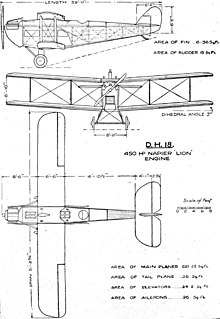The Aircraft Manufacturing Company Limited (Airco) was an early British aircraft manufacturer. Established during 1912, it grew rapidly during the First World War, referring to itself as the largest aircraft company in the world by 1918.

The Vickers Vulcan was a British single-engine biplane airliner of the 1920s built by Vickers Limited at Brooklands Aerodrome, Surrey. It carried eight passengers and a pilot.

The Airco DH.4 is a British two-seat biplane day bomber of the First World War. It was designed by Geoffrey de Havilland for Airco, and was the first British two-seat light day-bomber capable of defending itself.

The de Havilland DH.60 Moth is a 1920s British two-seat touring and training aircraft that was developed into a series of aircraft by the de Havilland Aircraft Company.
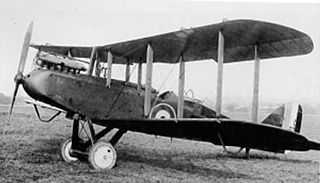
The Airco DH.9 – also known after 1920 as the de Havilland DH.9 – is a British single-engined biplane bomber that was developed and deployed during the First World War.
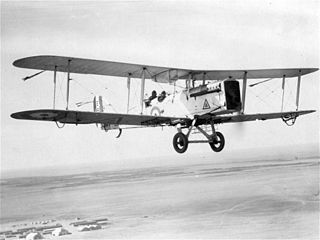
The Airco DH.9A is a British single-engined light bomber that was designed and first used shortly before the end of the First World War. It was a development of the unsuccessful Airco DH.9 bomber, featuring a strengthened structure and, crucially, replacing the under-powered and unreliable inline 6-cylinder Siddeley Puma engine of the DH.9 with the American V-12 Liberty engine.

The Westland Limousine was a 1920s British single-engined four-seat light transport aircraft built by Westland Aircraft.

The Airco DH.5 was a British First World War single-seat biplane fighter aircraft. It was designed and manufactured at British aviation company Airco. Development was led by aircraft designer Geoffrey de Havilland as a replacement for the obsolete Airco DH.2.

The de Havilland DH.66 Hercules was a British 1920s seven-passenger, trimotor airliner built by de Havilland Aircraft Company. With the Hercules, Imperial Airways took over responsibility for the airmail service from the Royal Air Force, which had been operating the obsolete Airco DH.10 Amiens.

The Airco DH.6 was a British military trainer biplane used by the Royal Flying Corps during the First World War. Known by various nicknames, including the "Clutching hand" and "Skyhook", many survived to be used as a civil light aircraft in the postwar era.
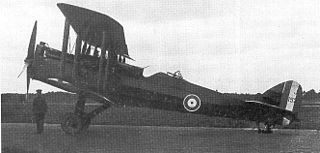
The de Havilland DH.14 Okapi was a British two-seat day bomber of the 1910s built by de Havilland. The aircraft was designed as an Airco DH.4 and DH.9 replacement, but it never entered production.

The Airco DH.16 was a British four-seat commercial biplane of the 1910s designed by Geoffrey de Havilland, the chief designer at Airco.

The Airco DH.10 Amiens was a twin-engined heavy bomber designed and produced by the British aircraft manufacturer Airco. It performed the first nighttime air mail service in the world on 14-15 May 1919.

Aircraft Transport and Travel Limited was a British airline formed during the First World War, a subsidiary of Airco. It was the first airline to operate a regular international flight.
Instone Air Line was an early British airline from 1919 to 1924. Along with other private airlines of the time, it was absorbed into Imperial Airways.

The de Havilland DH.34 was a single engined British biplane airliner built by the de Havilland Aircraft Company in the 1920s. 12 were built, with the DH.34 serving with Imperial Airways and its predecessors for several years.
Daimler Airway was an airline subsidiary of the Birmingham Small Arms Company (BSA)'s Daimler Company. It was created to use some of the assets of the failed ventures Airco and its subsidiary, Aircraft Transport and Travel, which was acquired by BSA in February 1920.

The 1922 Picardie mid-air collision took place on 7 April 1922 over Picardie, France, involving British and French passenger-carrying biplanes. The midair collision occurred in foggy conditions. A British aircraft flying from Croydon to Paris with only mail on board collided with a French aircraft flying three passengers from Paris to Croydon, which resulted in seven deaths.
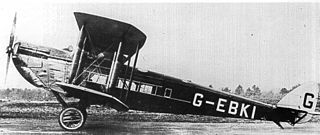
The de Havilland DH.54 Highclere was a single-engined 15-passenger biplane airliner designed to replace the DH.34. Its development ended when Imperial Airways decided to use only multi-engined types.
British Air Transport – The Pioneering Days 1919–1934 is an 8.44-metre (27.7 ft)-long mural by William Kempster depicting, from left to right, a chronological sequence of events in the history of British aviation on the London to Paris route starting on the left with Hounslow Heath Aerodrome in 1919 and finishing on the right at Croydon Aerodrome in 1931. The most recent aircraft shown is the Short L.17 Scylla of 1934.


